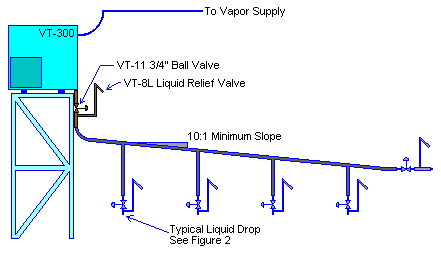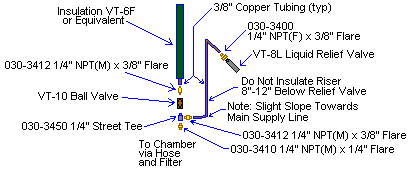
LIQUID LINE DESIGN
FOR
VT-300 CO2 SYSTEMS

LIQUID LINE DESIGN
FOR
VT-300 CO2 SYSTEMS
A properly designed liquid CO2 line is simple to design and install, and will save time, money, and frustration. A few rules peculiar to the piping of a boiling (or near boiling) liquid must be followed, but other than these the installation is very routine. A tempting misconception is to design a liquid CO2 distribution line for a fluid flowing under the influence of a 300psi pressure drop. Whenever the solenoid valve at the end of the line is closed, the pressure increase at the bottom of the line is due only to weight of the liquid, not the vapor pressure of the CO2 in the satellite. The hydraulic head accounts for a maximum pressure increase in any CO2 distribution line of only a few psi.
Vapor Traps Liquid CO2 at 300 psig and 0oF is at its boiling point, even the smallest amount of added heat will generate vapor. This vapor displaces the CO2 liquid and will rise to seek the highest point that it can. A vapor trap will be formed at any isolated rise on a liquid distribution line between the end point and the VT-300. A high point on this line is a perfect place for vapor to collect and begin to displace liquid. This "vapor trap" will prevent the flow of liquid to the solenoid valve and allow the entire branch of the liquid line to warm up. As soon as the valve on the end of the line is opened, liquid will rush past this vapor filled area and will be forced to cool the line down as it passes, generating additional vapor.
Because liquid CO2 is a volatile fluid at its boiling point, the temptation to treat liquid CO2 like water can lead to some very inefficient distribution systems.
Ideal Liquid CO2 Line: Ideally, a liquid line will supply saturated or slightly subcooled liquid CO2 to each temperature chamber. Temperature chambers, especially microprocessor controlled chambers, work most efficiently when supplied with this type of liquid CO2. Unsaturated liquid CO2 results in difficulty maintaining a desired temperature range and inefficient operation.
Two solutions: Two methods of meeting or closely approaching the criteria of an ideal line are discussed in the following paragraphs. 1) Minimize heat intrusion by using a line as short as possible. 2) Use lines that encourage the vapor generated within the line to return to the VT-300 CO2 Satellite Reservoir.
Short Lines: An ideal liquid CO2 distribution system can be approached with short well insulated hoses between the VT-300 CO2 Satellite Reservoirs and the temperature chamber. The definition of "short" is related to the size of the chamber being supplied with liquid CO2. Small chambers typically demand less CO2 than larger chambers and require shorter liquid delivery lines. The liquid CO2 flow rate within the line is lower and vaporization is proportionately higher. Insulated sleeving is available in six foot lengths (VT-6F) so six foot insulated hoses are widely used. Custom length hoses are available through Va-Tran Systems allowing hose lengths to be kept to an absolute minimum.
If several chambers are connected to one VT-300, plumb an insulated line to the closest chamber and continue with "daisy chain" hoses to chambers that are farther out. These branch hoses can be made shorter than hoses connected directly back to the VT-300. The increased liquid CO2 flow in the common hose reduces the effect of CO2 vaporization due to heat intrusion.
Extended Liquid CO2 Distribution Lines are Possible: Longer insulated lines can be used if all vapor is returned to the satellite for recondensation ("vapor stripped") as shown in figure 1. A vapor stripped line with VT-300 Satellites mounted above the chambers can tolerate longer liquid lines providing the lines slope continuously downward to the chambers. As long as the vapor has a way to return to the VT-300 CO2 Satellite Reservoir to be recondensed, saturated liquid CO2 will be provided at each temperature chamber solenoid valve. A minimum negative 10% slope will provide a sufficient path for vapor return. Any slope greater than 10% is even more effective, many installations run the liquid line vertically.
Well insulated liquid lines forty or fifty feet in length are quite practical. Vapor returned to the satellite is easily recondensed by the VT-300 refrigeration system. The practical limit for vapor stripped lines is dictated by the ability of the VT-300 CO2 Satellite Reservoir to carry the extra refrigeration load of the CO2 vaporizing in the liquid line and the ability to return CO2 vapor while allowing liquid to flow downwards through the line.

Extended Liquid Line with Gravity Vapor Stripping
A high quality pipe or tube should be used when installing a Liquid CO2 Distribution System. The nominal pressure of the system is 300 psi. Type ACR copper tubing is well suited for this use in sizes up to 1 1/2" diameter. A Liquid Distribution line should be at least 5/8" diameter and lines up to 1" in diameter are often used. Va-Tran Systems recommends that all connections on the liquid line be brazed (not soldered) using a brazing alloy with a minimum 15% silver content. Whenever brazing on a liquid line, an inert cover gas such as N2 or CO2 should be employed to prevent oxidation of the internal surface of the pipe and fittings. This cover gas can be bled through the tubing very slowly. Care must be taken not to allow pressure to build up within the tubing and fittings or the joints formed will leak. Whenever elbows must be used, long radius fittings should be employed providing minimum impedance to liquid or vapor flow.
Installation: It is advisable to install a valve at the liquid outlet of the satellite to allow for service of the liquid line without draining the entire reservoir. A Full-Throat ball valve (VT-11) placed vertically will allow vapor to freely return to the satellite. This liquid line supply valve will be used rarely and it is probably desirable to place a note or placard indicating that the valve should remain open at all times. As with all valves on the liquid distribution system, a liquid relief valve (VT-8L) should be installed as a pressure relief device (figure 1). The entire liquid distribution line should be insulated using a high quality insulation. VT-6F is closed cell neoprene pipe insulation available in six foot lengths providing a minimum 5/8" of insulation. All joints in this insulation should be wrapped with self adhesive foam as should all valves and other fittings (except VT-8L and vapor riser). If properly insulated there should not be any place on a liquid line, especially relief valves where ice will form. When affixing the liquid distribution line to supports, do not clamp the insulation, this will decrease its thickness and therefore its ability to keep heat away from the liquid line. Ideally, the line can be suspended on wide supports, alternatively, 2" plastic pipe can be cut into short sections (2" to 4" long) and the insulated pipe run through these sections every 6 to 10 feet.
Liquid Line Protection: Liquid CO2 expands considerably as it warms up, and high pressures can develop in the liquid line if liquid CO2 is trapped. Any liquid output valve on the VT-300 should remain open so this cannot happen. Liquid distribution lines should have a relief valve suitable for use with liquid CO2 (VT-8L) placed in each section of liquid line which could be isolated by valves being closed intentionally or inadvertently. The relief valve should be mounted with a tee and extend vertically on an uninsulated riser 9 to 12 inches above the liquid hose or line. The outlet of the relief valve should point downwards and away from anything that might be damaged by a burst of CO2 vapor. Relief Valves should never be allowed to become coated with ice or water, a relief valve that has a ball of ice surrounding it is likely to be non-functional. A typical protected liquid drop is shown in Figure 2.
If valves are necessary for each chamber: When several small chambers are clustered around one VT-300 satellite it is sometimes desirable to put ball valves on the liquid line segments to facilitate the removal of one chamber while others are running. If this is done, every possible segment of the liquid line should be protected with a relief valve. Since lines contain small volumes of liquid, a self reclosing relief valve like the VT-8L is suitable.

Liquid CO2 Drop
Connection of Liquid Line to Chamber Solenoid Valve: It is best to install a line filter such as the VT-17 at the solenoid valve input connection to prevent any foreign debris from contaminating the solenoid valve and injector. It is important that all connections be leak-tight since escaping liquid CO2 will excessively chill the solenoid valve. Liquid CO2 leaks chill the adjacent mass to -109.7oF which often shrinks other parts and causes more leaks. Throughout the system, Teflon* tape should never be used as a pipe sealant, but rather a paste type of pipe sealant with Teflon* should be used.

677 ANITA STREET, SUITE A, CHULA
VISTA, CALIFORNIA 91911
phone: 619/423-4555 toll free 800/379-4231 fax:
619/423-4604
Copyright 1998, Va-Tran Systems
Incorporated.